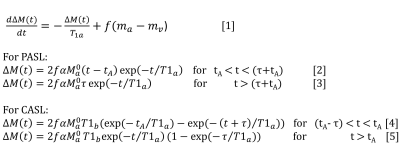Basic Perfusion
Basic Perfusion
Weekend Course
Weekend Course
ORGANIZERS: Fernando Calamante, Hanzhang Lu, Jongho Lee
Sunday, 12 May 2019
| Room 710A | 08:00 - 11:50 | Moderators: Hanzhang Lu, Shin-Lei Peng |
Skill Level: Basic
Session Number: WE-17
Overview
This basic course will introduce the background on acquisition and analysis of arterial spin labeling (ASL), dynamic-susceptibility contrast (DSC) MRI, and dynamic contrast-enhanced (DCE) MRI.
Target Audience
Basic scientists and clinicians interested in MRI methods to measure perfusion, permeability, tissue viability, and brain function.
Educational Objectives
As a result of attending this course, participants should be able to:
- Identify the most suitable acquisition strategies for measuring perfusion using ASL and DSC-MRI and for measuring permeability using contrast agents;
- Describe the key issues in the extraction of physiological parameters from ASL, DSC, and DCE data; and
- Describe how ASL principles can be used to measure physiological parameters beyond CBF.
Overview
This basic course will introduce the background on acquisition and analysis of arterial spin labeling (ASL), dynamic-susceptibility contrast (DSC) MRI, and dynamic contrast-enhanced (DCE) MRI.
Target Audience
Basic scientists and clinicians interested in MRI methods to measure perfusion, permeability, tissue viability, and brain function.
Educational Objectives
As a result of attending this course, participants should be able to:
- Identify the most suitable acquisition strategies for measuring perfusion using ASL and DSC-MRI and for measuring permeability using contrast agents;
- Describe the key issues in the extraction of physiological parameters from ASL, DSC, and DCE data; and
- Describe how ASL principles can be used to measure physiological parameters beyond CBF.
| 08:00 |
ASL Acquisition methods
Luis Hernandez-Garcia
This segment of the course will introduce the audience to the main varieties of arterial spin labeling schemes, as well as the practical considerations and options for image readouts. The technical details and practical considerations for implementation will be discussed from an engineering point of view.
|
|
| 08:25 |
 |
ASL: Analysis
Laura Parkes
ASL acquisition produces perfusion-weighted images through the subtraction of label and control images. These may be collected at a single post-labelling delay time or at multiple delay times. How do we extract quantitative CBF from these subtraction images? Quantification is important as the signal in the perfusion-weighted images will be affected by parameters other than blood flow, principally arterial transit time, labelling efficiency and the T1 and equilibrium magnetisation of blood. These may vary on an individual and/or regional basis. In this talk I will describe the most widely used method for quantification (Alsop et. al. 2015) and explain which parameters are most important for CBF accuracy.
|
| 08:50 |
ASL: Advances
Lirong Yan
Multiple physiological parameters other than CBF can be derived from ASL signal when the magnetically labeled blood passes through arterial trees and freely diffuses across the blood-brain barrier in capillaries, such as dynamic MR angiography, arterial cerebral blood volume (aCBV), vascular compliance (VC), and water permeability. This lecture will cover these recently developed advanced ASL techniques.
|
|
| 09:15 |
ASL: Reproducibility, Multi-Site & Validation
Henk Mutsaerts
This lecture focuses on the reproducibility of arterial spin labeling (ASL). Several interconnected factors influence the reliability of ASL. Mainly, investigators should strive to keep sequence parameters as identical as possible between different ASL datasets, whether this concerns a single-center scanner software update or pooling of different multi-center ASL datasets. Second, the consistency of ASL quantification parameters between sequences should be validated, for which the ASL-BIDS format is introduced. Third, it is important to acknowledge how (patho-)physiology determines the reliability of ASL. Finally, the definition of ASL image quality and recognition of artifacts should be standardized.
|
|
| 09:40 |
Break & Meet the Teachers | |
| 10:10 |
DSC-MRI: Acquisition
Jerrold Boxerman
DSC-MRI has been used in the brain since the early 1990s, (1,2) with multiple applications to gliomas, including treatment response assessment. (3) However, incorporation into multi-center clinical trials has been limited. This presentation briefly summarizes DSC-MRI acquisition methodology; the need for standardizing DSC-MRI for multi-site trials, as illustrated by application to pseudoprogression (PsP) and pseudoresponse (PsR); (4-6) and ongoing efforts to achieve this goal.
|
|
| 10:35 |
DCE-MRI: Acquisition
Chad Quarles
The overall purpose of this educational lecture is to discuss conventional and state-of-the-art acquisition methods for DCE-MRI. Topics will include protocol design informed by contrast mechanisms, sensitivity and spatiotemporal demands and advances in DCE-MRI acquisition methods based on technological advances (e.g. novel sampling schemes) and designed to enhance sensitivity to a greater range of physiologic properties.
|
|
| 11:00 |
DSC-MRI: Analysis
Ona Wu
Learn how to make perfusion maps and understand potential confounds.
|
|
| 11:25 |
DCE-MRI: Analysis
Linda Knutsson
This educational presentation gives an overview how to analyse data obtained from a Dynamic Contrast Enhanced (DCE) MRI experiment in order to retrieve perfusion and/or perfusion-related parameters.
|
|
| 11:50 |
Lunch & Meet the Teachers |
 Back to Program-at-a-Glance |
Back to Program-at-a-Glance |  Back to Top
Back to Top